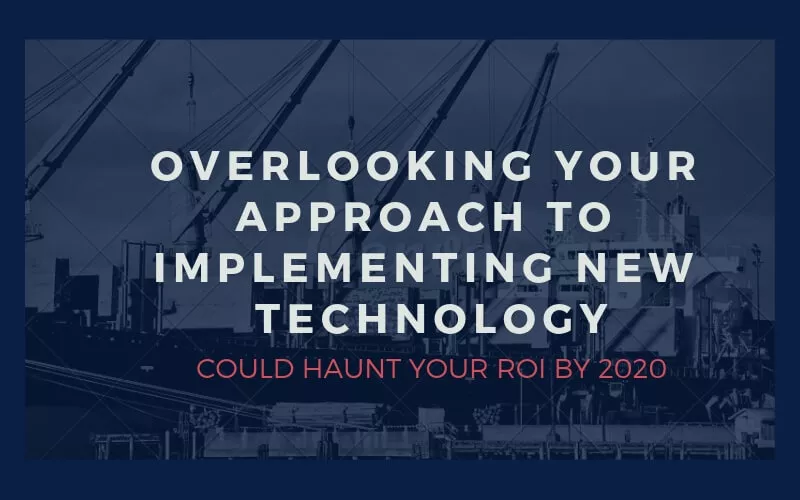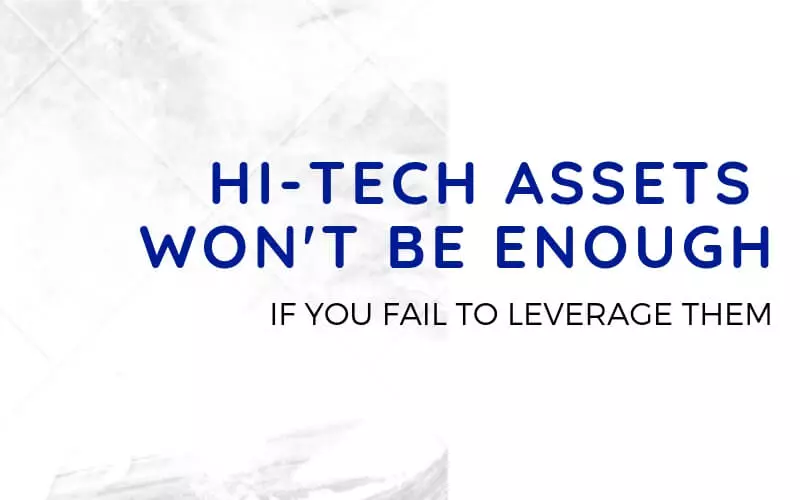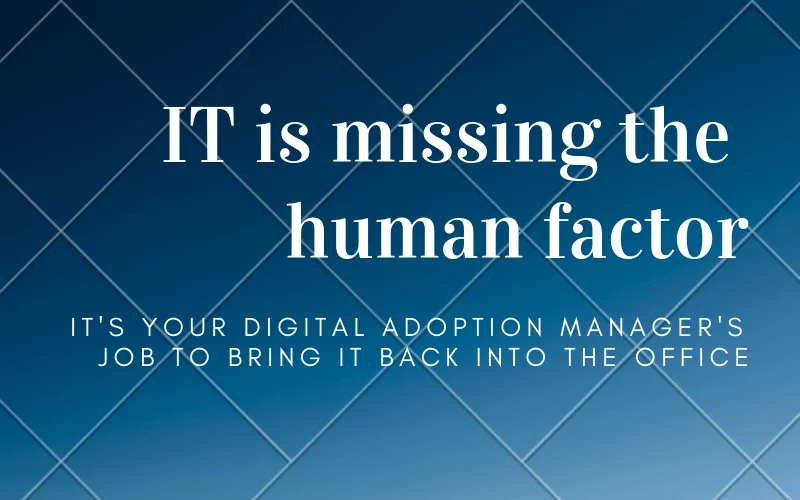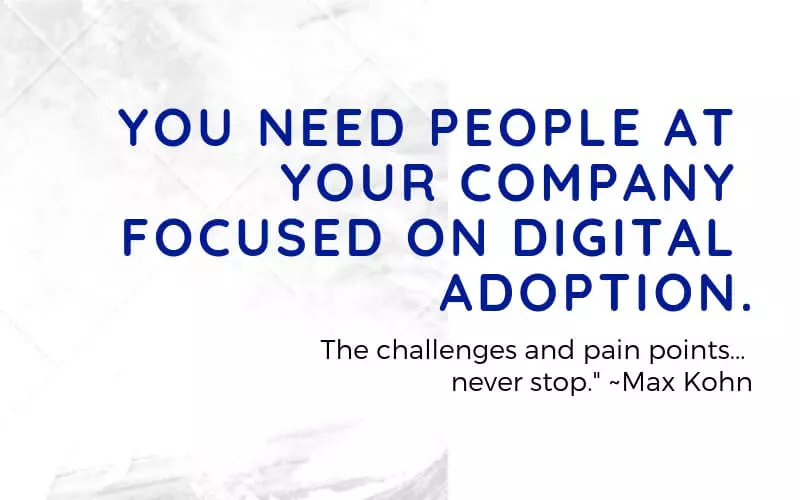We all have heard of the infamous RMS Titanic and its disastrous maiden voyage. A century ago, an Olympic-class ocean liner made a beeline to the ocean floor. It haunts us to this day — a prime example of how a random oversight could flood even an industrial pearl of its times.
The steel ship was branded as indestructible. Millionaires banked this passenger liner king would rule the seas, from size to tech.
But Titanic met its match with an iceberg collision, cracking in two.
 One overlooked pain point, and the whole ship sinks.
According to Forbes, 84% of companies fail at digital transformation.
If you’re implementing changes without a connector between new tech and the human experience, according to McKinsey, you might as well just be “…rearranging the deck chairs on the Titanic.”
Overlooking your approach to implementing new technology could haunt your enterprise’s ROI by next year.
The businesses that realize transformation first must achieve a state of digital adoption. Only when digital tools are used as designed, and to their utmost extent, will your team keep pace with a shifting tech landscape.
One overlooked pain point, and the whole ship sinks.
According to Forbes, 84% of companies fail at digital transformation.
If you’re implementing changes without a connector between new tech and the human experience, according to McKinsey, you might as well just be “…rearranging the deck chairs on the Titanic.”
Overlooking your approach to implementing new technology could haunt your enterprise’s ROI by next year.
The businesses that realize transformation first must achieve a state of digital adoption. Only when digital tools are used as designed, and to their utmost extent, will your team keep pace with a shifting tech landscape.
 Who is in the best position to streamline your new technology?
A savvy advisor who can identify the pain points jeopardizing your business.
Hi-tech assets won’t be enough to steer your ship if you fail to leverage them. Navigating smoothly today means your employees can efficiently adopt the technology. After all, if you ignore the employee experience, inadequate training for digital tools provokes frustration.
Above all, to lay the course for successful digital transformation, you need a trailblazer keyed into the human experience. A digital adoption manager will never risk forgetting that the people using technology are the ones who propel your ship.
But without a manager fluent in the value of your digital arsenal, companies confront tech anarchy. This iceberg sinks productivity and employee engagement.
Who is in the best position to streamline your new technology?
A savvy advisor who can identify the pain points jeopardizing your business.
Hi-tech assets won’t be enough to steer your ship if you fail to leverage them. Navigating smoothly today means your employees can efficiently adopt the technology. After all, if you ignore the employee experience, inadequate training for digital tools provokes frustration.
Above all, to lay the course for successful digital transformation, you need a trailblazer keyed into the human experience. A digital adoption manager will never risk forgetting that the people using technology are the ones who propel your ship.
But without a manager fluent in the value of your digital arsenal, companies confront tech anarchy. This iceberg sinks productivity and employee engagement.
 In a swirl of applications, CIOs today have “lost visibility into the lives of employees,” says Max.
New systems shouldn’t be the enemy of human processes.
Digital adoption managers help CIOs gain back “visibility into the adoption and utilization” of systems company-wide. “[We capture] a bird’s eye view of productivity across the company,” adds Max.
Digital adoption managers bring a necessary human element into software utilization.
Too often, digital transformations are plagued by information overload. A tech “lieutenant” who knows how your new tools are supposed to work will protect the quality of data integration and integrity. IT is missing the human factor — and it’s your digital adoption manager’s job to bring it back into the office.
Research firm IDC crunched big data market numbers globally in 2016. The size scaled up to a whopping $136 billion a year.
But according to IBM’s projection, the expense of poor quality data in the U.S. that same year was brutal: a whopping $3.1 trillion.
In a swirl of applications, CIOs today have “lost visibility into the lives of employees,” says Max.
New systems shouldn’t be the enemy of human processes.
Digital adoption managers help CIOs gain back “visibility into the adoption and utilization” of systems company-wide. “[We capture] a bird’s eye view of productivity across the company,” adds Max.
Digital adoption managers bring a necessary human element into software utilization.
Too often, digital transformations are plagued by information overload. A tech “lieutenant” who knows how your new tools are supposed to work will protect the quality of data integration and integrity. IT is missing the human factor — and it’s your digital adoption manager’s job to bring it back into the office.
Research firm IDC crunched big data market numbers globally in 2016. The size scaled up to a whopping $136 billion a year.
But according to IBM’s projection, the expense of poor quality data in the U.S. that same year was brutal: a whopping $3.1 trillion.
 As 2018 comes to an end, we predict that by 2019, a digital adoption manager will prove to be essential to maintaining the health of your business.
“Your business is complicated and it takes people to understand it. You need people at your company focused on digital adoption to really solve for the challenges and pain points you have on an ongoing basis. It never stops,” says Max.
As a digital adoption manager, Max speaks of cleaning up the fragments.
Every business has blind spots. You need a new right-hand lieutenant to see with peripheral vision — someone who will eye other ships chasing you and the icebergs that could sink your enterprise.
A company without a digital adoption manager looks like every department individually attempting to manage tech challenges. But there’s “no clear ownership” or understanding of how to prioritize what potential icebergs could hinder the enterprise-wide structure.
In an era of digital transformation, you can’t afford to miss the changing “icebergs” each day.
Your digital adoption manager should be the first on deck to spot when there’s a new process on the horizon — and dive into unseen challenges cracking your ship.
Without a digital adoption manager, by 2020, you’ll be haunted with “noise,” solutions that fail to generate consistent value, lost time… and wrecked transformation. No matter how high-powered the technology is on your ship.
As 2018 comes to an end, we predict that by 2019, a digital adoption manager will prove to be essential to maintaining the health of your business.
“Your business is complicated and it takes people to understand it. You need people at your company focused on digital adoption to really solve for the challenges and pain points you have on an ongoing basis. It never stops,” says Max.
As a digital adoption manager, Max speaks of cleaning up the fragments.
Every business has blind spots. You need a new right-hand lieutenant to see with peripheral vision — someone who will eye other ships chasing you and the icebergs that could sink your enterprise.
A company without a digital adoption manager looks like every department individually attempting to manage tech challenges. But there’s “no clear ownership” or understanding of how to prioritize what potential icebergs could hinder the enterprise-wide structure.
In an era of digital transformation, you can’t afford to miss the changing “icebergs” each day.
Your digital adoption manager should be the first on deck to spot when there’s a new process on the horizon — and dive into unseen challenges cracking your ship.
Without a digital adoption manager, by 2020, you’ll be haunted with “noise,” solutions that fail to generate consistent value, lost time… and wrecked transformation. No matter how high-powered the technology is on your ship.
Table of Contents
hide
Your company is not “unsinkable” by digital icebergs
 One overlooked pain point, and the whole ship sinks.
According to Forbes, 84% of companies fail at digital transformation.
If you’re implementing changes without a connector between new tech and the human experience, according to McKinsey, you might as well just be “…rearranging the deck chairs on the Titanic.”
Overlooking your approach to implementing new technology could haunt your enterprise’s ROI by next year.
The businesses that realize transformation first must achieve a state of digital adoption. Only when digital tools are used as designed, and to their utmost extent, will your team keep pace with a shifting tech landscape.
One overlooked pain point, and the whole ship sinks.
According to Forbes, 84% of companies fail at digital transformation.
If you’re implementing changes without a connector between new tech and the human experience, according to McKinsey, you might as well just be “…rearranging the deck chairs on the Titanic.”
Overlooking your approach to implementing new technology could haunt your enterprise’s ROI by next year.
The businesses that realize transformation first must achieve a state of digital adoption. Only when digital tools are used as designed, and to their utmost extent, will your team keep pace with a shifting tech landscape.
The “how” to steer transformation: digital adoption management
High-profile leaders realize it’s important to change organizational structure. That said, the stumbling block seems to be “how.” With the rise of digital adoption paves a need for new leadership: a digital adoption manager (like our own Max Kohn, WalkMe’s Digital Adoption Manager). The Digital Adoption Manager role is driving the digital adoption initiative front row and center within the company. Hiring a digital adoption manager provides a fundamental missing link between your employees and IT. Consider the role of a digital adoption manager as the lieutenant of your ship. Transformation today calls for a right-hand authority who understands the human struggle of adopting new tools. A digital adoption manager meets with stakeholders across your organization to pinpoint where productivity is being compromised. This “lieutenant” knows the ins and outs of your company’s inefficiencies.Learn how a Digital Adoption Platform (DAP) makes software adoption easy. Request a demo today.
When designing and implementing solutions, you need a leader who prioritizes business values without sacrificing the user experience. To steer through the tech abyss, it’s essential to build out solutions that overcome human challenges — as soon as possible.Here’s why you need a lieutenant aboard ship immediately
 Who is in the best position to streamline your new technology?
A savvy advisor who can identify the pain points jeopardizing your business.
Hi-tech assets won’t be enough to steer your ship if you fail to leverage them. Navigating smoothly today means your employees can efficiently adopt the technology. After all, if you ignore the employee experience, inadequate training for digital tools provokes frustration.
Above all, to lay the course for successful digital transformation, you need a trailblazer keyed into the human experience. A digital adoption manager will never risk forgetting that the people using technology are the ones who propel your ship.
But without a manager fluent in the value of your digital arsenal, companies confront tech anarchy. This iceberg sinks productivity and employee engagement.
Who is in the best position to streamline your new technology?
A savvy advisor who can identify the pain points jeopardizing your business.
Hi-tech assets won’t be enough to steer your ship if you fail to leverage them. Navigating smoothly today means your employees can efficiently adopt the technology. After all, if you ignore the employee experience, inadequate training for digital tools provokes frustration.
Above all, to lay the course for successful digital transformation, you need a trailblazer keyed into the human experience. A digital adoption manager will never risk forgetting that the people using technology are the ones who propel your ship.
But without a manager fluent in the value of your digital arsenal, companies confront tech anarchy. This iceberg sinks productivity and employee engagement.
 In a swirl of applications, CIOs today have “lost visibility into the lives of employees,” says Max.
New systems shouldn’t be the enemy of human processes.
Digital adoption managers help CIOs gain back “visibility into the adoption and utilization” of systems company-wide. “[We capture] a bird’s eye view of productivity across the company,” adds Max.
Digital adoption managers bring a necessary human element into software utilization.
Too often, digital transformations are plagued by information overload. A tech “lieutenant” who knows how your new tools are supposed to work will protect the quality of data integration and integrity. IT is missing the human factor — and it’s your digital adoption manager’s job to bring it back into the office.
Research firm IDC crunched big data market numbers globally in 2016. The size scaled up to a whopping $136 billion a year.
But according to IBM’s projection, the expense of poor quality data in the U.S. that same year was brutal: a whopping $3.1 trillion.
In a swirl of applications, CIOs today have “lost visibility into the lives of employees,” says Max.
New systems shouldn’t be the enemy of human processes.
Digital adoption managers help CIOs gain back “visibility into the adoption and utilization” of systems company-wide. “[We capture] a bird’s eye view of productivity across the company,” adds Max.
Digital adoption managers bring a necessary human element into software utilization.
Too often, digital transformations are plagued by information overload. A tech “lieutenant” who knows how your new tools are supposed to work will protect the quality of data integration and integrity. IT is missing the human factor — and it’s your digital adoption manager’s job to bring it back into the office.
Research firm IDC crunched big data market numbers globally in 2016. The size scaled up to a whopping $136 billion a year.
But according to IBM’s projection, the expense of poor quality data in the U.S. that same year was brutal: a whopping $3.1 trillion.
Read next: The race to win the digital business frontier
Bad data is expensive — and today, we don’t have to accept that price. A digital adoption manager simplifies the user experience, making it easier for employees to keep up with new processes. Use this leader behind-the-scenes to anticipate challenges, and change processes before tech slips happen. “I interact with employees, process owners, enablement teams, and department leaders to streamline process efficiency in every aspect of the life cycle of an employee,” explains Max. Moving forward, businesses will rely on digital adoption managers to “create a cohesive and unified way” of tackling new systems.Nonstop waves of digital change bring new challenges
 As 2018 comes to an end, we predict that by 2019, a digital adoption manager will prove to be essential to maintaining the health of your business.
“Your business is complicated and it takes people to understand it. You need people at your company focused on digital adoption to really solve for the challenges and pain points you have on an ongoing basis. It never stops,” says Max.
As a digital adoption manager, Max speaks of cleaning up the fragments.
Every business has blind spots. You need a new right-hand lieutenant to see with peripheral vision — someone who will eye other ships chasing you and the icebergs that could sink your enterprise.
A company without a digital adoption manager looks like every department individually attempting to manage tech challenges. But there’s “no clear ownership” or understanding of how to prioritize what potential icebergs could hinder the enterprise-wide structure.
In an era of digital transformation, you can’t afford to miss the changing “icebergs” each day.
Your digital adoption manager should be the first on deck to spot when there’s a new process on the horizon — and dive into unseen challenges cracking your ship.
Without a digital adoption manager, by 2020, you’ll be haunted with “noise,” solutions that fail to generate consistent value, lost time… and wrecked transformation. No matter how high-powered the technology is on your ship.
As 2018 comes to an end, we predict that by 2019, a digital adoption manager will prove to be essential to maintaining the health of your business.
“Your business is complicated and it takes people to understand it. You need people at your company focused on digital adoption to really solve for the challenges and pain points you have on an ongoing basis. It never stops,” says Max.
As a digital adoption manager, Max speaks of cleaning up the fragments.
Every business has blind spots. You need a new right-hand lieutenant to see with peripheral vision — someone who will eye other ships chasing you and the icebergs that could sink your enterprise.
A company without a digital adoption manager looks like every department individually attempting to manage tech challenges. But there’s “no clear ownership” or understanding of how to prioritize what potential icebergs could hinder the enterprise-wide structure.
In an era of digital transformation, you can’t afford to miss the changing “icebergs” each day.
Your digital adoption manager should be the first on deck to spot when there’s a new process on the horizon — and dive into unseen challenges cracking your ship.
Without a digital adoption manager, by 2020, you’ll be haunted with “noise,” solutions that fail to generate consistent value, lost time… and wrecked transformation. No matter how high-powered the technology is on your ship.
__________
WalkMe’s Digital Adoption Platform (DAP) transforms the user experience in today’s overwhelming digital world. Using artificial intelligence, engagement, guidance, and automation, WalkMe’s transparent overlay assists users to complete tasks easily within any enterprise software, mobile application or website. Discover how a DAP can revolutionize your business — request a demo today.
